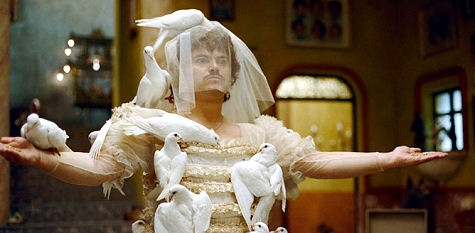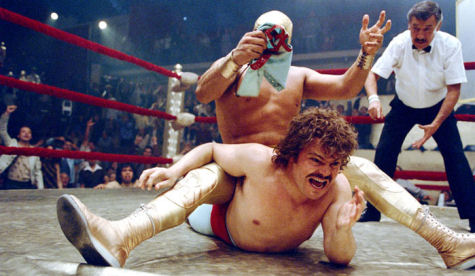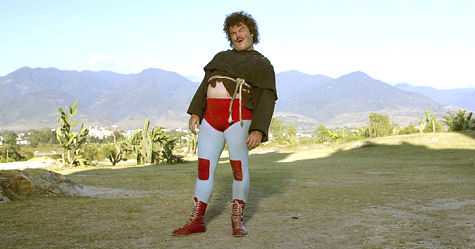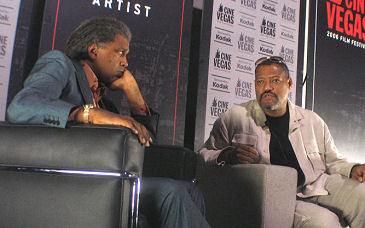There are obliquely satirical elements here and there in Carl Colpaert ‘s G.I. Jesus but to call it “a topical satire that takes a harrowing and humorous look at a Mexican national’s brief furlough from the frontlines,” in the words of Variety‘s Justin Chang, strikes me as a very strange take. Chang isn’t “wrong” but…
 Jeffrey Wells
Jeffrey Wells
Mexican Goof Ride
At the risk of sounding brusque, Jared Hess’s Nacho Libre (Paramount, 6.16) is to Napoleon Dynamite, his breakout debut film, as Wes Anderson’s The Life Aquatic is to Rushmore or Bottle Rocket.
I know, I know — that’s a damning thing to say. But I’m only trying to qualify what’s right and (only occasionally) wrong with it. It’s really not that much of a letdown.

Jack Black in Jared Hess’s Nacho Libre (Paramount, 6.16)
Let’s acknowledge once again that Jack Black is an authentic genius — it’s not just the manic-volcanic energy inside him, but the way he ladels it out just so, like a mad scientist pouring liquids into glass beakers — and I so enjoyed being in his and Hess’s good company that I didn’t feel that put off during the slack parts.
What’s wrong with Nacho Libre? The style and consistency of attitude are there in full bloom, but you can feel a lack of story tension manifesting around the halfway mark, and it starts to get a tiny bit enervated. And yet it’s a tonally together film, and the funny stuff that works (only about a third of the movie feels “off”) is screamingly nutso, so it all kind of balances out.
< ?php include ('/home/hollyw9/public_html/wired'); ?>
I was basically down with it because of the consistency of the Jared Hess signa- ture. I muttered to myself at one point, “Thank God this movie wasn’t directed by Jay Roach.” Every scene, shot, line and edit in Nacho Libre tells you it was made by a very sharp, ultra-disciplined director who’s in touch with his own particular brand of static flaky-weird humor, and who totally gets the Black trip.
Will Nacho Libre‘s reception be a replay of Napoleon Dynamite‘s? Dismissed by some (I remember all those boomer-aged distribution execs going “naaah” after the first Library screening in Park City) but embraced as a cult thing? I don’t know (kinda doubt it), but there were three or four guys sitting behind me at yesterday’s Nacho Libre screening in Las Vegas who were howling at every bit.
You could argue that Hess’s problem as a director is that he’s too much into the idea of a movie as a series of scenes and statements, and in maintaining the deadpan-ironic attitude at all costs, but not enough into the basics of telling a good story.

Written by Hess, Mike White and Jerusha Hess (and Black, of course, whose sensibility is all over this film), Nacho Libre is basically one big Mexican joke — an affectionate but at the same time snide and smart-assed portrait of that country’s culturally primitive traditions. Apologies to my Latin friends, but I enjoyed the impudence of this.
Black plays a be-robed Catholic monk named Nacho who doesn’t like living a life of denial and humility. This isn’t revealed right away, but Nacho’s basic yearning is to make money, be a wresting star (a “luchadore”), and make it with the very hot Sister Encarnacion (Ana de la Reguera)…the only problem being their mutual vows of celibacy.
Nacho’s job in the old Oaxaca monastery he shares with other priests is to prepare meals for the orphans who also live there. But there’s no money for basics so all Nacho can do is throw together plates of flavorless bean dip and tortilla chips.
Nacho gradually takes the bull by the horn when he hooks up with a girlyman thief named Esqueleto (Hector Jimenez) — shades of Napoleon hooking up with Pedro — and proposes that they become a luchadore wrestler team, and then use their earnings to buy better ingredients for the orphan meals and white patent-leather shoes for Black to wear as he’s putting the moves on de la Reguera.

Black carries the whole thing, and the story basically breaks down as follows: (a) Black having a special relationship with fat orphan kid who gets his trip and believes in him, (b) his sneaking out of the monastery to wrestle in the evenings, (c) gradually sharing his inner feelings with Reguera, (d) making inroads into the world of the luchadore with Jimenez at his side, (e) dealing with the unmasking of his luchadore deception, and (f) a final spurt of dejection, despair and then triumph.
I loved Jimenez’s performance — freaky, quasi-feminine, hilarious. I got into the steady supportive gaze coming from the fat kid (can’t identify his real name from online cast lists). I especially enjoyed Black’s performing of two Mexican-flavored tunes, one a spur-of-the-moment ditty he sings at a party, the other a kind of inspirational Tejano love song.
And I generally loved tripping through Black’s beautifully measured performance, which is most likely going to be seen as politically incorrect — offensive — by some in the Latin sector. Applause to Black for having the cojones to not be afraid of this.
Said it before, saying it again: Black should have made a movie with Stanley Kubrick. If Kubrick’s health hadn’t given out and these two had somehow hooked up with the right project, it might have been like Kubrick and Peter Sellers all over again.
Bernard’s Diet Book
With everyone doing articles about established film critics getting whacked or demoted and/or losing their influence because they’re thought to be out of touch with the cyber generation (here’s an argument against that myth by Entertainment Weekly‘s Owen Gleiberman), I naturally presumed that a forthcoming book by recently dismissed Daily News film critic Jami Bernard called “The Incredible Shrinking Critic” would be about this syndrome. And it’s not. It’s a book about Bernard’s “excellent adventure in weight loss.” It’ll probably sell, come to think of it. (Sorry for misspelling Ms. Bernard’s first name in an earlier edit.)
Hollywood Wiretap is linking to JoBlo.com’s 6/12 posting that Paramount Pictures has bumped David Fincher‘s Zodiac out of its previous mid-to-late November slot to January 2007, even though I reported evidence of this date change three days ago (i.e., Sunday, 6.11). I’ve since been told by Paramount publicity that the Zodiac bump was decided upon months ago, even though right now the IMDB still has it listed as an 11.22.06 release. This is a long and ambitious real-life whodunit with quality-level actors (Jake Gyllenhaal, Mark Ruffalo, Robert Downey, Chloe Sevigny) that screams “fall or holiday release.” Okay, it has additional shooting scheduled, but it’s only mid-June with six and a half months to go before December 31st. There’s simply no reason to bump a movie of this calibre out of the fall or year-end release sked unless the studio has determined that (a) critical support might be spotty or (b) it’s not enough of an “audience film”. (Traditionalists might have issues with a period drama about chasing a serial killer who doesn’t get caught or face the music in any significant way at the finale.) Paramount is obviously feeling qualms of some kind, and I’m betting there are a lot of disap- pointed fans out there. I’ve read the script and written a piece about it. I can’t see how it wouldn’t be some kind of fascinating, high-quality ride, given the Fincher sensibility and all. How much of an uncommercial mixed bag can it be?
So what happened to the heat over Nacho Libre? Last month I kept hearing that audiences were laughing at the trailer, that it was the summer’s big comedy slam-dunk, etc. I hope I’m not stepping into another Break-Up situation, but recent tracking on Nacho Libre (Paramount, 6.16) indicates a not-that-great opening weekend. Maybe a little more than $20 million, I mean. There’s a chance, in fact, that The Fast and Furious: Tokyo Drift (Universal, 6.16) might ace it out. Another film that’s not looking all that vigorous is The Devil Wears Prada (20th Century Fox, 6.30). Hold on…what happened to the hairdresser bandwagon? I thought every hairdresser in the U.S. and a portion of his/her clientele was going to catch Prada over the 4th of July weekend. Maybe that’ll happen, but the figures say a sizable audience isn’t forming in support of poor Prada as an alternative to Superman Returns. You could argue and say, “Hey, what’s wrong with an opening weekend gross in the mid teens?” Well, there’s nothing “wrong” with it, exactly…
Taking time out from Cinevegas this evening to see Nacho Libre at the Orleans megaplex in Las Vegas…the moment arrives.
Vegas photos #3

Elvis Mitchell interviews Lawrence Fishburne in front of large crowd at Brenden Cinemas #13 in concert with Fishburne receiving the Cinevegas Half-Life Award — Monday, 6.12.06, 8:20 to 9:05 pm.
(a) Anyone who says they prefer coming to Las Vegas and taking in fake atmosphere crap like this instead of experiencing the real thing in Venice, Italy, or Paris, France, has a serious problem — Monday, 6.12.06, 9:40 pm; (b) Oversized Bellagio Bell sitting in a cavernous passageway between one of the many visual-climax stations inside L.V.’s Bellagio hotel, which is so massive and sprawling (it’s a five-football-field walk from one point of interest to another) that it makes you feel like a powerless ant — Monday, 6.12.06, 9:05 pm; (c) Bellagio Fountain show — Monday, 6.12.06, 9:15 pm; (d) Bellagio view #1; (e) Bellagio view #2; (f) Bellagio view #3.
“I would love to find condoms…it’s kind of disgusting to be pawing around other people’s personal waste.” — Private eye John Nazarian, a guy who’s apparently stepped into Anthony Pellicano‘s shoes, speaking to L.A. Times writer Rachel Abramowitz.
Ann Coulter vs. George Carlin on Jay Leno Wednesday night…this ought to be good, right?
AICN is quoting from a forum commentary written by longtime Danny Elfman orchestrator Steve Bartek on his own website that Elfman has removed his name from the credits of Nacho Libre (Paramount, 6.16). “A couple of the main cues we spent lots of time on were taken out and replaced with music Danny didn’t want to be associated with,” Bartek reportedly wrote, “and I believe he was upset about the way the studio treated him in doing the replacement — not very above-board — so most of the score is still Danny’s but his name will not be there.” Not on the closing credit crawl, he means? Elfman’s name is still listed on the IMDB as the film’s composer.
“Toshiba has introduced a $500 HDTV player that, at least for now, can only play movies from three major studios. Later this month, Samsung will release the first Blu-ray machine, which will be able to play more movies, but it is expected to cost about $1,000. Technical hurdles were behind Pioneer’s decision last week to delay the release of its Blu-ray player — which will cost about $1,500 — until September. Studios have released only a handful of movies thus far because so few players have been sold. Another complication is that consumers with older high-definition television sets may not get the best possible picture if studios activate certain copy protection software embedded on their DVD’s.” — from Ken Belson’s story about the state of the DVD business. What a complete joke! Why would anyone except for profligate money-to-burn rich guys buy a HDTV player of any brand? The thing to do is obviously wait until all the DVD distribs are making high-def discs for just one player. The hell with it.
The story is not that Jim Carrey and manager Eric Gold are on the negotiating ropes — the story is that sanity is creeping into the judgment of big-studio execs who determine whether to green-light big-budget films. I’ve long felt that the system of paying $20 to $25 million fees and/or massive gross point percentages to big stars who can presumably “open” a film is a bad thing for the business as a whole. (Especially considering that a big name appearing in a shitty no-interest film never seems to make a financial difference.) Big talent should be decently compensated, but the really big money shouldn’t kick in until the film is a hit. (And if it’s not, too bad.) Everyone should share in the risk. In any case, it’s very, very encouraging that big studios are taking a second look at rich deals and developing a “cold feet syndrome,” as Slate‘s Kim Masters reports. “Paramount is pushing back Believe It or Not, a mega-budget project that was to be directed by Tim Burton and star Jim Carrey. The studio has instead switched Burton to a film version of Sweeney Todd, a far less expensive project belonging to DreamWorks (which is now owned by Paramount). This leaves Carrey in the awkward position of having had two major films vanish in the space of a few weeks. Before Believe It or Not, Carrey was supposed to be making Used Guys for Fox. That comedy, directed by Jay Roach (Meet the Parents), was also to star Ben Stiller. With millions of dollars spent in preparation, Fox pulled the plug recently as the budget climbed to $112 million.” Given the economics of the business these days”, Masters concludes that “cold feet” is “a syndrome that may occur with increasing frequency.” Could the Paramount and Fox turndowns be analagous to the first stirrings of anti-socialist fervor in Eastern Europe in 1989?
